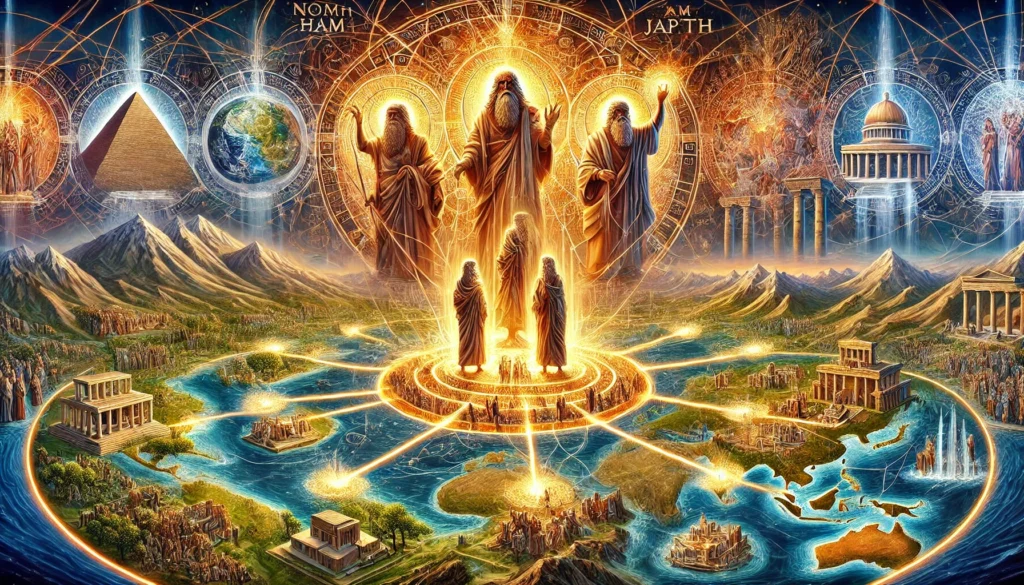The Table of Nations
- This is the account of Shem, Ham and Japheth, Noah’s sons, who themselves had sons after the flood.
The Japhethites - The sons of Japheth: Gomer, Magog, Madai, Javan, Tubal, Meshek and Tiras.
- The sons of Gomer: Ashkenaz, Riphath and Togarmah.
- The sons of Javan: Elishah, Tarshish, the Kittites and the Rodanites.
- (From these the maritime peoples spread out into their territories by their clans within their nations, each with its own language.)
The Hamites - The sons of Ham: Cush, Egypt, Put and Canaan.
- The sons of Cush: Seba, Havilah, Sabtah, Raamah and Sabteka. The sons of Raamah: Sheba and Dedan.
- Cush was the father of Nimrod, who became a mighty warrior on the earth.
- He was a mighty hunter before the LORD; that is why it is said, “Like Nimrod, a mighty hunter before the LORD.”
- The first centers of his kingdom were Babylon, Uruk, Akkad and Kalneh, in Shinar.
- From that land he went to Assyria, where he built Nineveh, Rehoboth Ir, Calah
- and Resen, which is between Nineveh and Calah—which is the great city.
- Egypt was the father of the Ludites, Anamites, Lehabites, Naphtuhites,
- Pathrusites, Kasluhites (from whom the Philistines came) and Caphtorites.
- Canaan was the father of Sidon his firstborn, and of the Hittites,
- Jebusites, Amorites, Girgashites,
- Hivites, Arkites, Sinites,
- Arvadites, Zemarites and Hamathites. Later the Canaanite clans scattered
- and the borders of Canaan reached from Sidon toward Gerar as far as Gaza, and then toward Sodom, Gomorrah, Admah and Zeboyim, as far as Lasha.
- These are the sons of Ham by their clans and languages, in their territories and nations.
The Semites - Sons were also born to Shem, whose older brother was Japheth; Shem was the ancestor of all the sons of Eber.
- The sons of Shem: Elam, Ashur, Arphaxad, Lud and Aram.
- The sons of Aram: Uz, Hul, Gether and Meshek.
- Arphaxad was the father of Shelah, and Shelah the father of Eber.
- Two sons were born to Eber: One was named Peleg, because in his time the earth was divided; his brother was named Joktan.
- Joktan was the father of Almodad, Sheleph, Hazarmaveth, Jerah,
- Hadoram, Uzal, Diklah,
- Obal, Abimael, Sheba,
- Ophir, Havilah and Jobab. All these were sons of Joktan.
- The region where they lived stretched from Mesha toward Sephar, in the eastern hill country.
- These are the sons of Shem by their clans and languages, in their territories and nations.
- These are the clans of Noah’s sons, according to their lines of descent, within their nations. From these the nations spread out over the earth after the flood.
Genesis 10, often called the “Table of Nations,” provides a genealogical record of Noah’s descendants after the Flood. This chapter details how humanity repopulated and spread across the earth through Noah’s three sons: Shem, Ham, and Japheth. It highlights the origins of various nations and peoples, emphasizing God’s fulfillment of the command to fill the earth.
- Descendants of Japheth:
- Japheth’s lineage includes Gomer, Magog, Javan, Tubal, Meshech, and Tiras.
- His descendants primarily settled in the coastal regions and islands, forming the Indo-European nations. They are associated with the “Gentiles” who spread widely over the earth.
- Descendants of Ham:
- Ham’s descendants include Cush, Mizraim, Put, and Canaan.
- From Cush came notable figures like Nimrod, described as a mighty hunter and the founder of cities such as Babel, Erech, and Nineveh, which became prominent centers of power and culture.
- The Canaanites, another branch of Ham’s descendants, settled in regions that would later be significant in Israel’s history, including Sodom, Gomorrah, and Sidon.
- Descendants of Shem:
- Shem’s lineage is associated with the Semitic peoples. His descendants include Elam, Asshur, Arphaxad, Lud, and Aram.
- Through Arphaxad, the line leading to Abram (later Abraham) is established, marking Shem’s importance in the biblical narrative.
- The Spread of Nations:
- The chapter concludes by emphasizing how the descendants of Noah’s sons spread out according to their languages, lands, and nations. This distribution forms the foundation of the ancient world’s various peoples and cultures.
Genesis 10 underscores the unity of humanity through a shared ancestry and the diversity that arose as they spread across the earth. It sets the stage for the subsequent narrative of the Tower of Babel in Genesis 11.

Join us on this journey by subscribing to our newsletter and exploring more resources on HisScripture.com. Together, let’s grow in faith and share God’s love with the world.